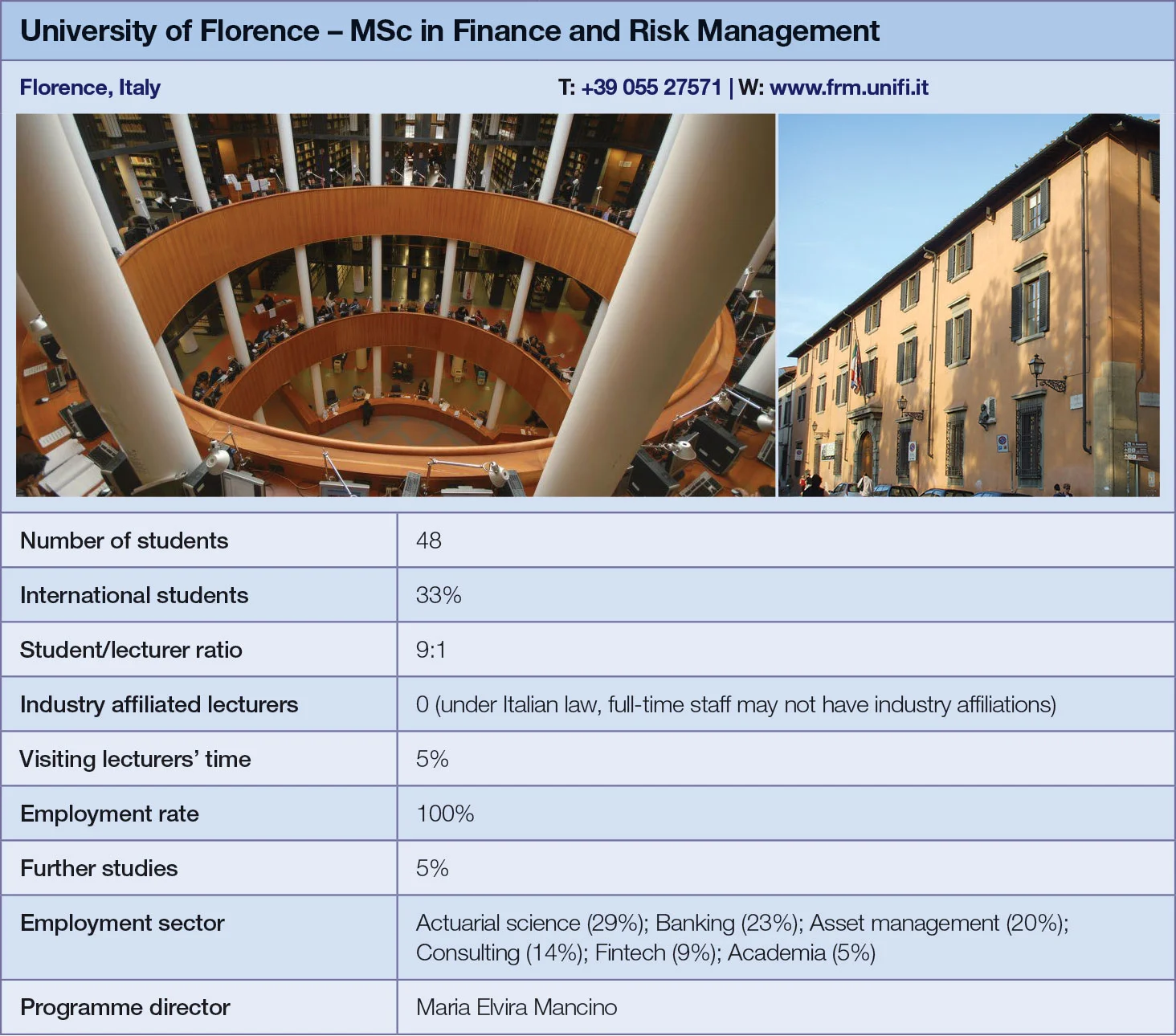
Quant Guide 2017: University of Florence
Florence, Italy

MSc in Finance and Risk Management | metrics table at end of article
While many quant finance schools tout their links with the financial industry, the University of Florence places the emphasis elsewhere. “Some quant finance degrees are very focused on the market or the business side. A large part of this degree is spent covering fundamental matters,” says Antonio Iannizzotto, a professor on the university’s master’s programme in finance and risk management. “Where we want to keep up-to-date is in the workshop space.”
The university website describes the two-year, English-language programme as “a combination of economic theory for finance with mathematical methods – probability theory, statistics, numerical analysis – for finance and insurance”. Students are not allowed to choose their courses until the second year; Iannizzoto explains: “We want to give them knowledge of specific subjects.” The optional subjects are taught in what are known as workshops rather than classes, and cover new topics such as ethical finance or provide additional training in topics covered earlier.
“On the insurance side, we would like to introduce a workshop on innovation in insurance. What we currently teach is classic insurance,” says Iannizzotto.
All but one of the teachers on the programme are academics rather than practitioners. The exception is Lorenzo Parrini, partner at Deloitte, who runs the workshop in advanced corporate finance.
Simone Biondi graduated with the master’s in 2015 and currently works at Bloomberg as an equity analyst. “The master’s was well structured,” he says. “You have a good overview of all aspects of finance: corporate finance, derivatives, computational finance and a little bit of accounting.” There is no cap on the number of students.
Under a recently signed agreement, students can spend their second year at Warsaw School of Economics on the master’s in finance and accounting, obtaining both degrees at the end. In each academic year, up to five students from each of the two master’s programmes can make the switch.

Click here for links to the other universities and an explanation of how to read the metrics tables
Only users who have a paid subscription or are part of a corporate subscription are able to print or copy content.
To access these options, along with all other subscription benefits, please contact info@risk.net or view our subscription options here: http://subscriptions.risk.net/subscribe
You are currently unable to print this content. Please contact info@risk.net to find out more.
You are currently unable to copy this content. Please contact info@risk.net to find out more.
Copyright Infopro Digital Limited. All rights reserved.
You may share this content using our article tools. Printing this content is for the sole use of the Authorised User (named subscriber), as outlined in our terms and conditions - https://www.infopro-insight.com/terms-conditions/insight-subscriptions/
If you would like to purchase additional rights please email info@risk.net
Copyright Infopro Digital Limited. All rights reserved.
You may share this content using our article tools. Copying this content is for the sole use of the Authorised User (named subscriber), as outlined in our terms and conditions - https://www.infopro-insight.com/terms-conditions/insight-subscriptions/
If you would like to purchase additional rights please email info@risk.net
More on Quantitative finance
Quant Finance Master’s Guide 2023
Risk.net’s guide to the world’s leading quant master’s programmes, with the top 25 schools ranked
Baruch topples Princeton in Risk.net’s quant master’s rankings
US schools cement top five dominance as graduate salaries soar
Is it worth doing a quant master’s degree?
UBS’s Gordon Lee – veteran quant and grad student supervisor – asks the hard question
Starting salaries jump for top quant grads
Quant Guide 2022: Goldman’s move to pay postgrads more is pushing up incomes, says programme director
Quant Finance Master’s Guide 2022
Risk.net’s guide to the world’s leading quant master’s programmes, with the top 25 schools ranked
Princeton, Baruch and Berkeley top for quant master’s degrees
Eight of 10 leading schools for quantitative finance programmes are based in US, latest rankings show
Quant grad conveyor belt stalls as banks retrench
Jobs market is long quant graduates, short vacancies – but hiring freeze shows signs of thawing
Quant Finance Master’s Guide 2021
Risk.net’s guide to the world’s leading quant master’s programmes, with the top 25 schools ranked
Most read
- Basel Committee reviewing design of liquidity ratios
- Breaking out of the cells: banks’ long goodbye to spreadsheets
- Too soon to say good riddance to banks’ public enemy number one







